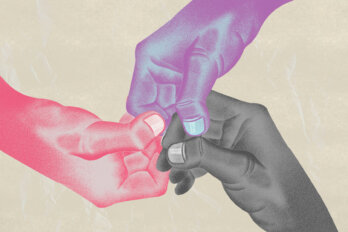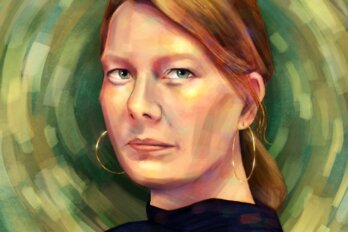The literary map is like the geological one: it’s three-dimensional. Mountains are leveled, rifts open, volcanoes suddenly appear where there were none before. Not so long ago, books by emigrés from the Soviet Union or its satellites were almost guaranteed a hearing in the West. Now, ever since 9/11, a catastrophe that is already a logo, the publishing hot spot has shifted to another incandescent region, the Middle East.
There’s scant mystery as to why. Like all sentient animals, we can smell the wind, and the wind brings the news, and the news is what we long for, because we need it. Spilled blood is a compelling scent. A wag once commented that what was really required for a country to produce a world-class literature was a powerful navy, which might be revised to “a strategically significant war.”
It’s a high price for the people of such countries to pay. That’s part of the news.
What did we think we knew about that part of the world, before the ground opened so spectacularly beneath our feet? We had such gauzy ideas. Children of my generation were likely to have been given an Arabian Nights, illustrated by Maxfield Parrish. Skies in these fabled lands were bluer than blue, gardens were lush, veiled princesses radiant, slave girls resourceful, bandits malevolent, genies obliging. It was all colourful and romantic and, finally, undependable, like Rudolph Valentino playing a sheikh.
At school we might have learned something about the Crusades, and Richard the Lion Heart. We might have come across The Rubáiyát of Omar Khayyám: in the Twenties, Thirties, and Forties, every literate house in North America was likely to have a copy. But then the moving finger wrote, and it was time for the Cold War, and our minds were on other things, and harem pants became merely a fashion statement. Apart from the occasional article in the National Geographic—the wonders of the Pearl Mosque, the gorgeousness of old carpets—we heard little from these places, and what little we had once known, we forgot.
It would be wise for us to remember now. How did things get this bad? We need to learn.
All of which is prelude to three new books by Iranian women writers. A second prelude would come in handy, because all three of these books were written in a context—Iranian history—which itself exists within the history of the wider Muslim world. Although included in the well-known “axis of evil” trio and thus a potential target for another pre-emptive U.S. war, Iran is not the same as Iraq—a country hammered together during the horse-trading that went on after the Great War—nor is it the equivalent of wild and mountainous Afghanistan. True, all are Muslim, all have oil—an extremely mixed blessing—and all have experienced several decades or more of civil war, repression, invasion, and unbelievable horror. But Iran is—and it prides itself in being—the Persia of old, once the centre of a sophisticated empire, renowned for the beauty of its gardens, the intricacy of its literature, and the refinement of its culture.
In the Muslim world, memories are long, so Amin Maalouf’s fascinating 1984 book, The Crusades Through Arab Eyes, is useful as a starter. In this period it was the Muslim world that was civilized and inventive—“modern,” if you like—and the West that supplied the nasty barbarians, and the most admirable leader was not Richard the Lion Heart but the Muslim hero, Saladin. (Readers of Ivanhoe knew that already, plus some peculiar quasi-factoids about the Knights Templar and their rapist proclivities.)
According to Maalouf, the events of the Crusades still deeply colour Muslim thinking. After the Crusades, “progress was the embodiment of ‘the other’. Modernism became alien. Should cultural and religious identity be affirmed by rejecting this modernism, which the West symbolized? Or, on the contrary, should the road of modernization be embarked upon with resolution, thus risking loss of identity… Even today we can observe a lurching alternation between phases of forced Westernization and phases of extremist, strongly xenophobic traditionalism.”
For a broad perspective on the most recent phase of the Islamist quarrel with the West, Bernard Lewis’s The Crisis of Islam: Holy War and Unholy Terror is indispensable. Lewis, a renowned Islamic scholar, explains in some detail how the West, and America in particular, got transformed into the Great Satan by the Islamists, and how very helpful that transformation has been for them. All political leaders bent on suppressing their own people need a Great Satan, or an axis of evil, or something of the sort, so that resistance to the leader can be portrayed as not only futile but heretical.
Perhaps the most necessary background book is Ryszard Kapuscinski’s artful and hair-raising 1982 classic, Shah of Shahs. Kapuscinski wrote it during the first years of the Iranian Revolution. It’s a report from the middle of the boiling cauldron—what it felt like to live through those blood-spattered years—but it’s also a long backward look. We’re reminded of how the late Shah’s brutal father was elevated to power by the British, who lusted after oil; of how Mossadegh became Prime Minister, brought in democracy for two years, and nationalized the country’s only oil company; of how he was overthrown by the second Pahlavi Shah, supported by the West; of this Shah’s reign of terror, with Savak, his secret police agency, let loose to assassinate and torture. Only against this background does the familiar outcome—the return of the ascetic and fanatical Ayatollah Khomeini, the struggle between modernizing leftish elements and religious extremists, the ascent of the punitive mullahs—make any kind of sense.
“These”—says one of Kapuscinski’s informants—“are the grim and brutal histories we hoard in our national memory. Tyrants won the throne by force, climbing toward it over corpses… The issue of succession was often settled in distant capitals, and the new pretender to the crown would enter Teheran with the British and Russian envoys supporting his elbows on either side. People treated such Shahs as usurpers and occupiers, and when one knows about that tradition one can understand how the mullahs managed to spark off so many uprisings against them.”
Kapuscinski watches as the mobs who demonstrated against the despotic Shah turn and rend one another, allow the desire for vengeance to possess them, and become despots in their turn. For a writer from Poland, then still under Soviet control, it was a familiar state of affairs. “[T]hose who have brought down a dictator often act, in spite of themselves, like his heirs, perpetuating the attitudes and thought patterns of the epoch they themselves have destroyed,” he comments. Toward the end of his grim account, he reflects, “A person, an individual being, … is riches without end, he is a world in which we can always discover something new. A crowd, on the other hand, reduces the individuality of the person; a man in a crowd limits himself to a few forms of elementary behaviour. The forms through which a crowd can express its yearnings are extraordinarily meager and continually repeat themselves: the demonstration, the strike, the rally, the barricades. That is why you can write a novel about a man, but about a crowd—never.” Which goes a long way toward explaining why despotisms have always aimed to suppress literature: They love the crowd and hate the individual, and literature is, above all, singular.
So much for the background. Now for the foreground: three singular books by Iranian writers, all women. Iran has produced many writers—the level of literary culture there is relatively high, as it has been for centuries—and increasingly, many of these writers have been women. The Iranian experience since 1979 has been of special interest to women—not only Iranian women, but women everywhere. Iranian women, by the second third of the Twentieth Century, had made a good deal of progress; they could acquire education, hold jobs, lead individual lives. Then they were shoved backwards, forced into the veil, deprived of most of their autonomy. Their fate reminds all women of the fragility of their so-called rights and freedoms, for under the rule of the Iranian mullahs the female body itself was transformed into a highly-charged symbol, a vehicle for their projections and religious fantasies. For human beings possessing such bodies, the outcome has rarely been happy.
Persepolis: The Story of a Childhood, by Marjane Satrapi, is a drawn autobiography, like Art Spiegelman’s Maus. There’s a short introduction: Her book, the author hopes, will be a tribute to the majority of Iranians who are not involved in “fundamentalism, fanaticism, and terrorism.” We then launch into the book proper, which begins with a picture of an ominous eye surrounded by black, and the chapter title: the veil.
This is the motif that dominates the narrative: Satrapi was ten in 1980, when the veil became mandatory at her school. But her family was “modern”—leftish and intellectual—and had been involved in protests against the Shah and his bloodbaths. Not only that, her grandfather had once been the Prince of Persia, whose own father had been overthrown by the first Reza Pahlavi, an illiterate army officer.
Through Satrapi’s charming, sometimes humorous, and often melancholy drawings, we meet her whole family, and follow its members from one gruesome national and personal trauma to the next. The most heartbreaking one concerns Satrapi’s beloved uncle, imprisoned under the Shah, but executed by the Islamic Revolution. Her book is less a call to arms than a testament: This is what it was like for one family to live through the dark times. Like so many creative people from Iran, Satrapi finally leaves for the West. Otherwise, we assume, her book could never have been published.
And so it is with Azar Nafisi, author of the engaging Reading Lolita in Tehran: A Memoir in Books. This book is also an autobiography of sorts, and covers the same time span as Persepolis. Nafisi, too, began as an anti-Shah leftist, a member of student protest groups during her college years in the United States. Her real passion was Western literature, however, and she returned to Iran to teach it just as the Shah’s regime was falling.
She, too, resisted the veil and the suppression of women it symbolized to her—under the Shah, for instance, the legal age for marriage was eighteen, but under the mullahs it went down to eight-and-a-half lunar years. (She tells of an interesting ruling by the Ayatollah Khomeini concerning chickens you’ve had sex with, a practice permitted so men would not vent their urges in illegal ways, on women. Are you allowed to eat such chickens? No, said the Ayatollah: Neither you nor your next-door neighbour may eat the chicken, but the family two doors down is allowed to do so. One envisages a lively local street traffic in chickens. This incident is emblematic of the weirdness of matters sexual in Iran at this time, a weirdness encountered in all three of these books.)
Finally, badgered both by the authorities and the fanatics among her students, Nafisi quit the University and set up a private reading group in her own home. Her adventures with Western literature in the Islamic Republic are essential for anyone who wants to know what life is like for women under this regime, but they also show Western literature itself in a different light. Jane Austen, for one, will never seem the same after Nafisi’s spirited defense of her work. Austen’s novels—and socially realistic novels in general, as distinct from other fictional prose forms such as romances—are democratic in essence, she believes, because all the characters are allowed to speak in their own voices, as they are, for themselves. Under a regime where only one voice is considered legitimate and the usual way to read literature is as an allegory, Jane Austen is transformed—oddly, for Western readers—into an agent for radical dissent.
Both Persepolis and Reading Lolita mention the obsession of the mullahs with sex, and both refer to one of the more hideous practices of the Revolutionary Guards: If a woman to be executed was a virgin, she was “married” in a bogus ceremony, then raped by one of the guards, because virgins go to heaven and the Guards wanted to prevent that. In Farnoosh Moshiri’s novel The Bathhouse, this motif moves from the sidelines to centre stage, for the bathhouse of the title is a holding pen for female political prisoners. The narrator of this spare and courageous novel ends up in the bathhouse as many did—through being related to someone who was politically involved—and is subjected to a number of grisly experiences, narrowly avoiding execution at the Wall of the Almighty.
Her escape, like her arrest, is a fluke: the Revolutionary Guards aren’t what you’d call methodical. There’s a large component of sadism and opportunism among them, not to mention superstition and borderline lunacy: It’s a firm belief among the bathhouse officials that if you can see the Great Leader’s face in the full moon, you’ve been blessed and are therefore saved. Many of the tormentors are women, including ex-prisoners who claim to have been “converted” and are terrified that the same will happen to them if they don’t participate.
Those familiar with holocaust literature will find themselves right at home, for as with crowds, so with tortures: The range of expression is limited. As Sartre pointed out in his introduction to The Question, which examines French behaviour in Algiers, the lesson most frequently learned by those who have been brutalized is how to do the same themselves.
A clear consensus emerges from all three of these books: The claims of the Iranian regime to purity of religion are nominal. The hijacking of religion by those bent on power grabs is an age-old theme and by no means limited to the Muslim world, but it must be a source of great sadness to the majority of Muslims to see how their faith has been twisted and misused. The Prophets warned against the conversion of false idols into gods, but here we see the conversion of God into a false idol.
It’s also true of any society that if you hand people a license to be vicious and tell them that the exercise of this viciousness is in a good cause—better, the cause of God—that license will be used to the full. The most frightening thing about such regimes is the emotional deadening and the sheer meanness they bring out in otherwise unremarkable people. A man may be “riches without end … a world in which we can always discover something new,” but such worlds range all the way from Heaven to Hell. Unfortunately, although we continue to dream of Heaven, we aren’t very good at creating it. We’re so much better at Hell.
This appeared in the October 2003 issue.





